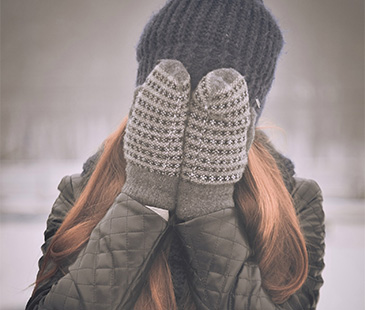Eczema in the Winter: Our Best Advice for the Most Common Winter Skin Conditions

By Dr. Corey Hartman
During the wintertime, while some people might be able to heal their dry skin with some small changes like steering clear of harsh soaps and upping their moisturizer game, there are just as many who find themselves with dry, bothersome skin that they just can’t cure.
If this sounds like you, you may be suffering from an eczema-based skin condition. Take a look below at some of the most common conditions I tend to see during the winter, plus some steps you can take to heal your winter skin fast.
The Four Most Common Types of Eczema, Plus How to Cure Each
Atopic Dermatitis: The Number One Form of Eczema
Eczema is an umbrella term, so when most people say eczema they usually mean atopic dermatitis. Atopic dermatitis is an autoimmune condition where the skin doesn’t maintain a good barrier and gets dried out easily.
While very common in children, yet also prevalent in adults, atopic dermatitis is often located in the bends of the arms and legs, and around the neck. They call it the “itch that rashes” because it starts with dry skin before getting itchy, and the more you scratch it, the more you itch. It’s a vicious cycle.
Best Treatment Options for Atopic Dermatitis
Atopic dermatitis usually requires a topical steroid or topical immuneiloginator, but there’s also a newer medicine out call Eucrisa, which is a steroid-sparing ointment that can be really helpful as well.
In addition to these treatments, there are many dos and don’ts you should keep in mind:
- Do invest in a good moisturizer and use a mild, fragrance-free laundry detergent.
- Don’t use harsh soaps, cleansers, or hand sanitizers since they contain alcohol.
- You’ll also want to avoid dryer sheets.
Asteatotic Dermatitis: The Most Common Eczema in Elderly Patients
Asteatotic dermatitis is basically the same thing as atopic dermatitis, except it can occur in different areas and mainly affects elderly patients. While older people don’t produce as much oil because they don’t have the same hormone profile, their skin is often inherently dry. Plus, some common medications, particularly cholesterol medication, can worsen the problem.
While it’s a very similar condition to atopic dermatitis, the treatment options are typically the same.
Pityriasis Alba: A Common Skin Condition in Children
Pityriasis Alba is a form of eczema that occurs mostly in children where you’ll start to see light patches on the face. This condition normally doesn’t become apparent until the spring when you’re out in the sun. That’s when the skin starts to pigment; yet this patch that’s been so inflamed looks like it’s turning lighter when it’s actually just not pigmenting like the rest of the skin.
In order to stay ahead of it, you just need to make sure you’re doing what you should be doing during the winter, including staying hydrated, applying a mild steroid, and moisturizing properly. This way, in the spring, you’re not a step behind.
Keratosis Pilaris: A Dry Skin Marker in Children
Keratosis pilaris occurs mostly in children and can be characterized by red skin and fine bumps on the upper outer arms, thighs, and face. This condition is caused by a lack of oil production, which leaves the skin so dry that it’s not exfoliating the hair follicles. That means it’s retaining those keratin parts that it would’ve normally exfoliated, and that’s why it feels really rough.
This problem will usually calm down while using a combination of hydroxy acids, like glycolic acid and lactic acid, that works to gently exfoliate the skin, and a thick, heavy moisturizer and mild soap.
As you can see, many of these conditions are easily treatable as long as you take the right steps. While you may not want to hear that it’s “just dry skin,” it’s important to understand the root of the problem. This way, you can ensure you’re doing what you need to do to keep your skin hydrated and moisturized throughout the winter.
Find expert Eczema Treatment at Skin Wellness Center of Alabama in Birmingham Today
At Skin Wellness Center of Alabama, we offer cutting-edge skin care and dermatology services to our patients in the Greater Birmingham area, including Hoover and Homewood. At our offices in Birmingham & Chelsea, AL, our certified dermatologists are here to listen to your concerns and offer the individualized, high level of patient care you seek. We believe in making care accessible and affordable, and we will go out of our way to accommodate your visit. Give us a call today at 205-871-7332.